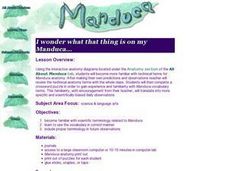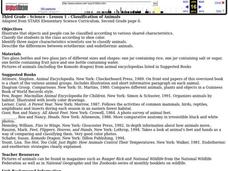Curated OER
Insect Anatomy
Break down insect anatomy with this worksheet! Class members diagram insect anatomy by drawing a line from the names of grasshopper body parts to the corresponding parts on an image of a grasshopper. The worksheet provides the word bank...
Curated OER
Insect Anatomy
In this science worksheet, young scholars learn the 3 parts of an insect's body by examining a labeled diagram. Students also read other facts about insect anatomy. Young scholars practice printing the names of the 3 parts of an insect's...
Curated OER
Invent an Insect
Explore biology by researching adaptation. First, learners research and define a list of insect vocabulary terms and discuss the benefits of each insect characteristic. They then utilize a worksheet to create their own insect and share...
Curated OER
Insects
Introduce your unit on insects with this six-slide PowerPoint presentation. Characteristics of an insect are briefly discussed, including two informative diagrams. Tip: After showing this presentation, ask students to share what they...
Curated OER
Adopt An Insect
In this insect activity, students choose a specific insect and complete a page with facts, diagrams and answers to questions. Students will need to research adaptations, defensive structures and scientific name.
Curated OER
Clay Ants: Insect Anatomy
Students examine anatomic structures in order to identify insects from other living organisms. They gain a level of comfort from anxiety when observing and handling live and pinned insects. They create clay models of an insect.
Cornell University
Let’s Raise Lacewings
Young entomologists explored beneficial insects and how they help control pests in the first lesson of the series. Now class members take a close look at the lacewing, which is a beneficial insect.
Curated OER
Ladybugs, Ladybugs, Ladybugs
Those lovely ladybugs are so cute, and so very useful! Use a short unit to explore insect anatomy, the ladybug life cycle, and the help ladybugs provide organic farmers. The unit is comprised of four short thirty-minute lesson plans that...
Curated OER
Entomology
Beginning with some general trivia about insects, this presentation is geared toward agricultural concerns. It covers binomial nomenclature and then examines six insect orders. Insect anatomy and life cycles are featured. The final two...
Curated OER
Insect Anatomy
In this insect instructional activity, students label the parts of an insect on a diagram and then write down one fact about each of the body parts. This instructional activity has 5 fill in the blank and 6 short answer questions.
Science Friday
Ugh, a Bug!
Young entomologists familiarize themselves with the physical characteristics of insects. Composed of two activities, each activity involves your scientists tapping into their prior knowledge of bugs and making observations of real live...
Curated OER
Insects Are Helpful!
Students see that insects do lots good and are very valuable to humans and nature. This is part of an ongoing effort to dispel fears of insects. They rotate through a series of centers that have examples of how insects contribute to our...
Curated OER
Beautiful Bovine
Looking for a fun and interactive way to explore bovine biology? Learners read a brief informational text (included for printing) before participating in several cross-curricular activities. First, grab their attention with a hilarious...
The Science Spot
Flower Basics
Learn about plants and pollination with a worksheet about the parts of a flower. After labeling the anatomy of a flower using a word bank, kids explain the difference between self-pollination and cross-pollination, and unscramble the...
Curated OER
Flower Dissection
Students dissect three different flowers and compare and contrast them. In this flowers lesson plan, students learn about the flower anatomy and then dissect their own flowers.
Curated OER
Ladybugs
In this ladybug life style worksheet, students match 7 body parts to a diagram of a ladybug and draw the 4 different stages of a ladybug's life cycle.
Curated OER
I Wonder What That Thing Is On My Manduca
Students use the internet to gather more information on the anatomy of the Manduca. They make predictions of what the insect will look like when it hatches and complete a crossword puzzle to practice their vocabulary. They continue to...
Curated OER
Water and Ice
Learners study the water cycle and states of matter. In this water cycle lesson, students observe ice for a period of time and record their observations. Learners create a Venn Diagram comparing water in solid form and liquid form....
Curated OER
Science: Birds in Flight
Students identify and examine adaptations in birds that enable them to fly. They conduct Internet research to relate these adaptations to the physics of flight. Students observe birds in flight and describe their behavior and flight...
Curated OER
Cloudy With a Chance of Meatballs
Fourth graders participate in a play to work on seeing events from a different perspective. Some of them are reporters, some cameramen and women, and others are interviewed. They put themselves in the shoes of the people in the book...
Curated OER
Classification of Animals
Third graders practice classiyfying items and identify three major characteristics scientists use to classify animals. They describe the differences between ectothermic and endothermic animals.






















